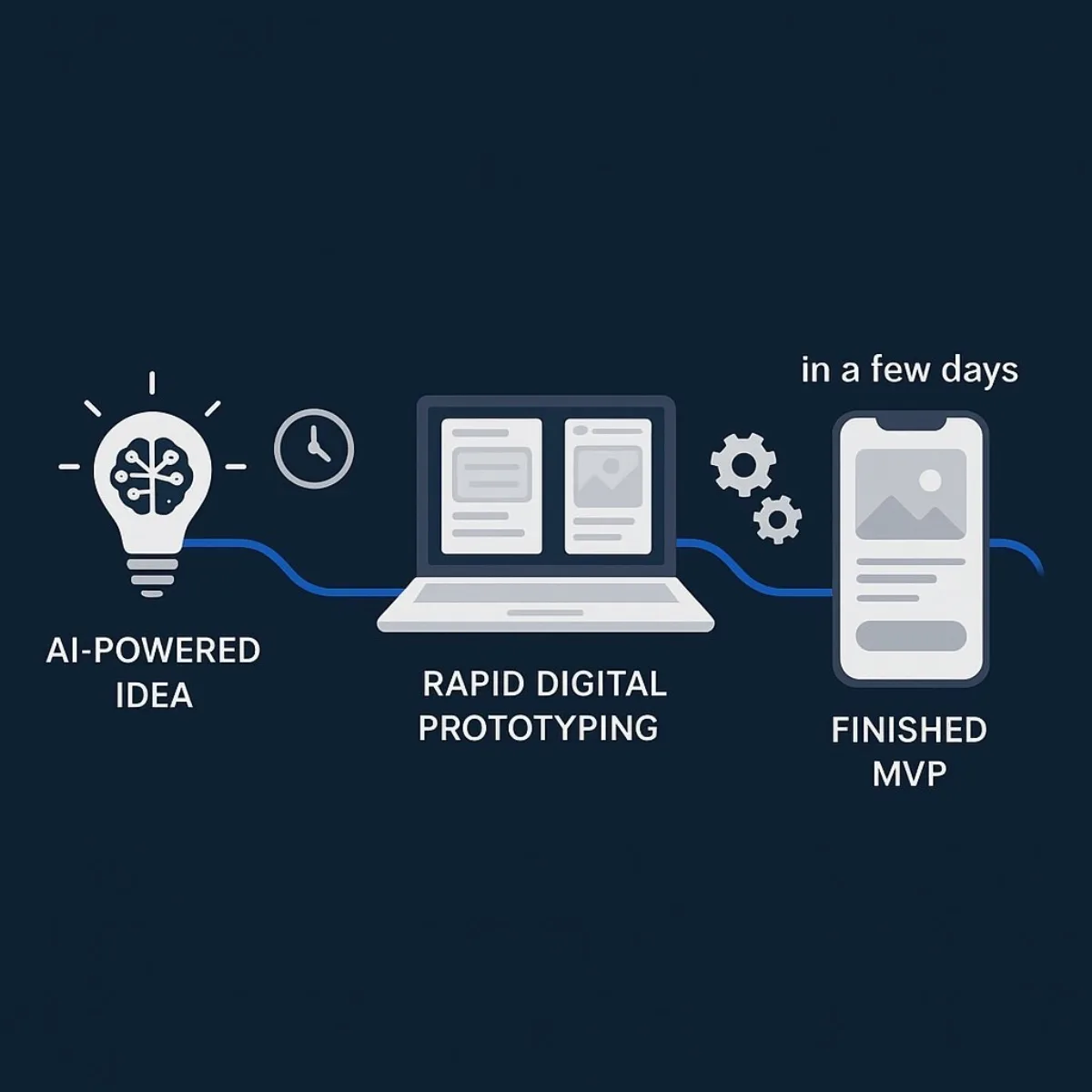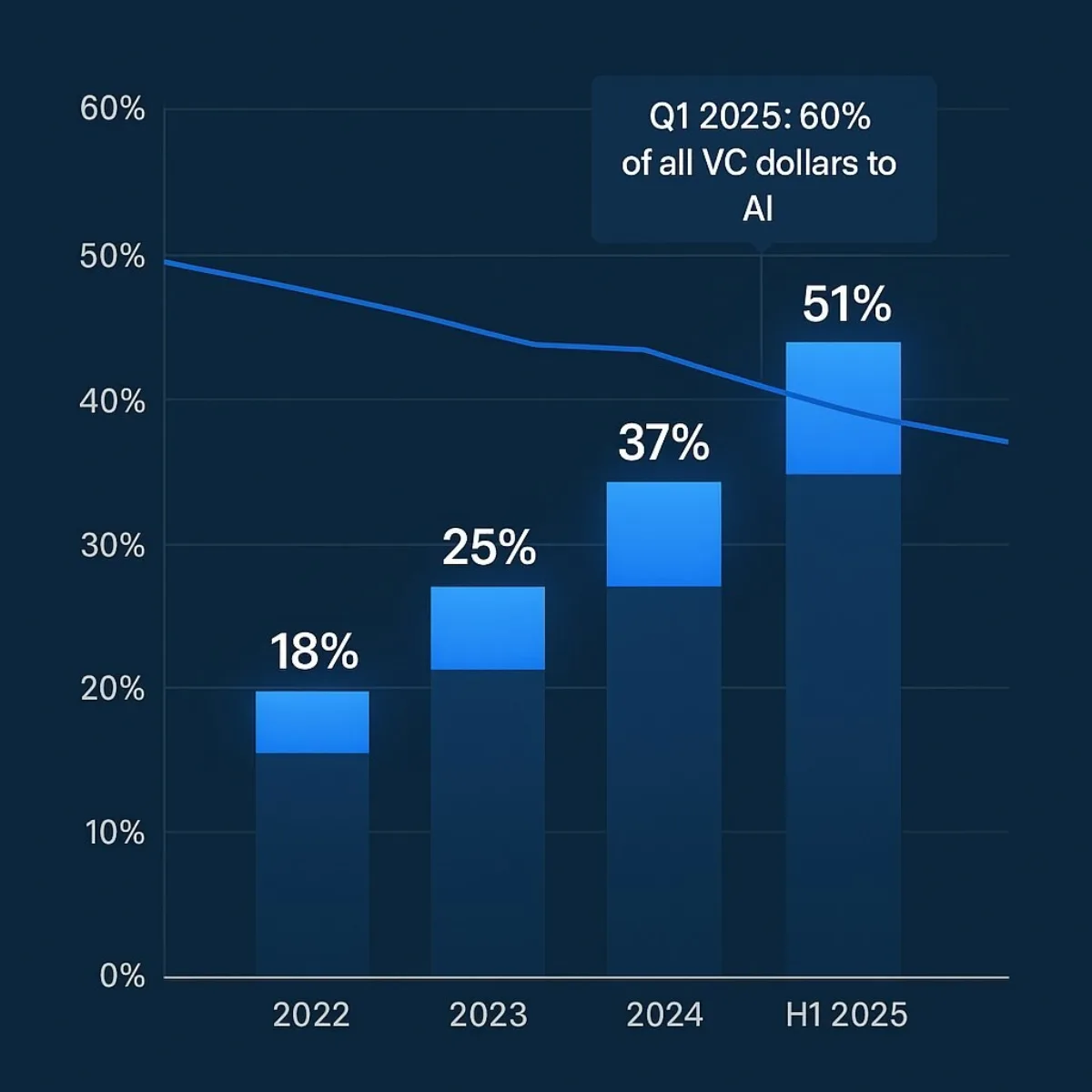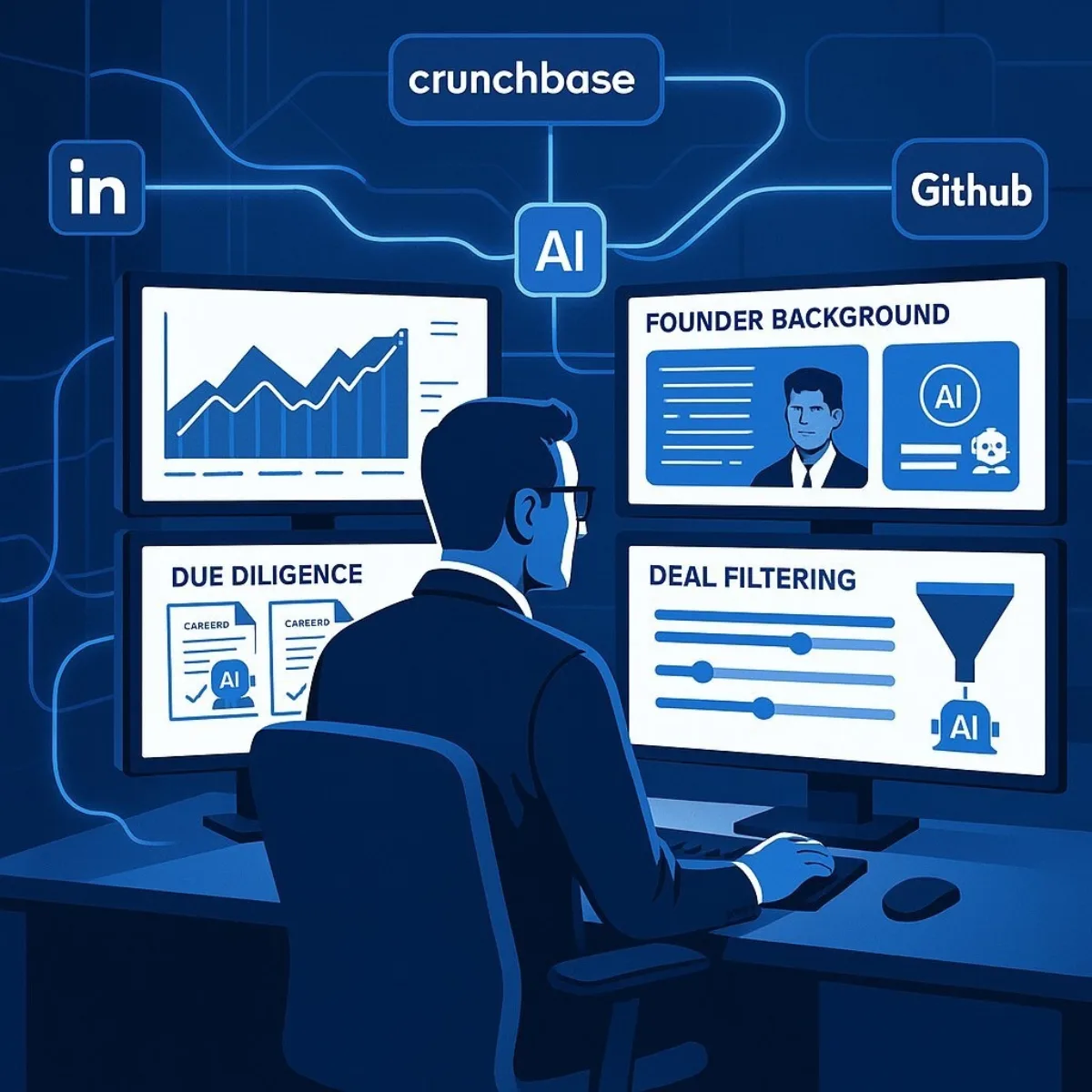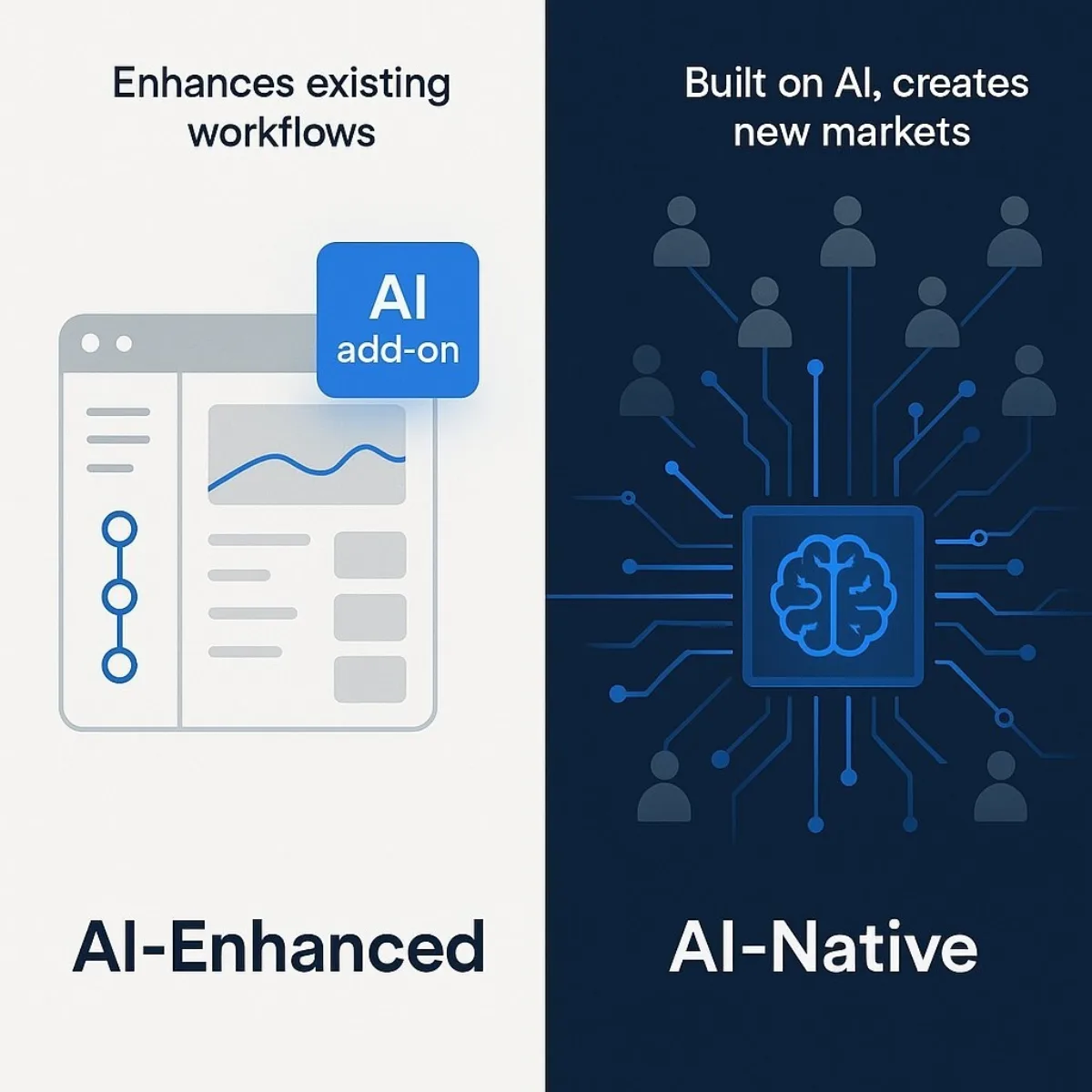
The Executive’s AI Playbook: Building, Funding & Scaling Startups in 2025
August 05, 2025 / Bryan Reynolds
The AI Startup Revolution: A B2B Executive's Guide to Building, Funding, and Scaling in the New Era
The term 'AI' is no longer a futuristic buzzword; it is the new operational reality. For startups, artificial intelligence is not just another tool—it is a fundamental rewiring of the very DNA of how companies are conceived, built, funded, and scaled. The playbook that created the last wave of unicorns is now obsolete. In this transformed landscape, the question for B2B executives is no longer if they should use AI, but how they will integrate it into their core strategy to survive and thrive.
This article cuts through the hype to provide a clear-eyed, data-driven guide for B2B executives navigating this new terrain. It dissects the impact of AI across the entire startup lifecycle, addressing the most pressing questions about building, funding, and scaling in the age of AI. We will explore the new rules of creation, the paradoxes of the funding market, the challenges of scaling, and the future frontiers of competition and ethics.
Part 1: The New Rules of Creation: How Has AI Changed How Startups Are Built?
The most immediate and profound impact of AI has been on the very process of creation. For executives asking if they can truly build products faster, cheaper, and with smaller teams, the answer is an unequivocal yes. AI has democratized the initial stages of company building, but in doing so, it has also dramatically raised the bar for what constitutes a viable, competitive product.
A. From Idea to MVP in Record Time: The End of the 'What If?' Phase
Historically, validating a startup idea was a capital-intensive and high-risk endeavor. Today, AI has drastically reduced the time and cost associated with this critical first step. Entrepreneurs can now leverage AI to perform deep market analysis, identify unserved gaps, and dissect competitor strategies before committing significant resources. By analyzing vast datasets from social media, customer reviews, and industry reports, AI tools can offer predictive insights into a startup's potential for success, allowing founders to modify business plans and pivot ideas with a level of data-backed confidence that was previously unattainable.
The speed of prototyping has been particularly transformed. Founders can now move from a conceptual idea—sometimes described as "vibe coding"—to a functional Minimum Viable Product (MVP) in a matter of days rather than months. This acceleration of the build-measure-learn loop enables more iterations, faster learning, and a quicker path to achieving the all-important product-market fit.
However, this newfound ease of creation introduces a significant challenge. When anyone can build a basic product quickly, the value of simply having a product plummets. The market becomes saturated with "me-too" AI wrappers and simple integrations, creating an "AI gold rush" atmosphere. This huge influx of entrants makes it harder than ever for a genuinely innovative startup to stand out. Consequently, competitive advantage no longer lies in the speed of building but in the depth and uniqueness of the problem being solved. A simple AI feature is no longer a differentiator; now, it’s just table stakes. Startups must demonstrate "razor-sharp positioning" and technical sophistication from day one to capture the attention of users and, importantly, investors.
B. The Rise of the Micro-Team: Doing More with Less
A direct consequence of AI's power is the emergence of formidable "small-by-design" startups. Companies that once required dozens of employees can now operate with remarkable efficiency and impact, using only skeleton crews. AI acts as a powerful equalizer, enabling these micro-teams to compete with resource-rich industry leaders through intelligent automation and predictive analytics.

This is made possible by the democratization of expertise. Modern AI platforms have flattened the knowledge curve across domains, allowing a solo technical founder to craft effective marketing copy or a non-technical founder to prototype a mobile app. This drastically lowers the barrier to entry and reduces the immediate need to hire large, multi-disciplinary teams. Core business functions—including marketing, finance, HR, and customer support—can now be heavily automated, freeing small teams to focus on high-value, strategic activities that drive growth.
C. The Product Development Lifecycle, Reimagined
AI is not just accelerating product development; it is fundamentally reshaping each stage of the lifecycle, from initial concept to post-launch iteration. Today, AI-enabled development processes help teams design, code, test, and deploy at levels of speed and quality that were previously unattainable, but also introduce new responsibilities around transparency and governance.
- Ideation and Design: In the earliest stages, AI tools accumulate and analyze data from diverse sources to pinpoint emerging market trends and generate novel product concepts. Generative AI can then automate the creation of multiple design variations and computer-aided design (CAD) models, facilitating rapid prototyping and allowing engineers to optimize for performance and manufacturability with unprecedented speed.
- Coding and Development: For developers, AI is a force multiplier. Low-code platforms like Dify.ai and AI-driven code assistants enable accelerated development, intelligent code refactoring, and a reduction in manual effort—transforming team productivity.
- Testing and Quality Assurance: The QA process is being revolutionized. AI can automate the execution of thousands of test cases with greater speed and accuracy than manual methods. More advanced systems can predict potential errors and identify edge cases before they become critical bugs, ensuring a higher-quality product and a faster, more reliable time-to-market.
- Launch and Iteration: Even after a product is launched, AI's role continues. It provides predictive insights into market reception and customer behavior, enabling teams to fine-tune launch strategies and marketing campaigns for maximum impact. Post-launch, AI-powered analytics monitor user engagement and feedback in real time, driving a continuous cycle of data-informed product improvements and personalization.
Part 2: The Funding Paradox: What Does the AI Investment Frenzy Mean for My Business?
The flow of capital into the AI sector has been nothing short of historic, leading many executives to wonder if it is now easier to secure funding. The reality, though, is far more complex. The headline-grabbing figures mask a fiercely competitive and increasingly bifurcated market—a funding paradox where more money is available overall, but it is harder for the average startup to access.
A. A Tsunami of Capital (with a Catch)
Venture capital funding for AI companies has shattered all previous records. In 2024, global VC investment in AI soared to over $100 billion, up more than 80% from 2023, with the sector capturing nearly one-third of all global venture funding. This trend accelerated further in 2025. The first quarter alone saw a record-breaking $73.6 billion invested in AI and machine learning startups across 1,600+ deals. AI’s share of global VC dollars shot up to nearly 60% in Q1 2025, up from 28% in the same period of 2024.
In North America, the concentration is even sharper, with AI startups grabbing nearly half of all VC dollars in 2024 and a staggering 70% in Q1 2025. Mega-deals—like OpenAI’s $40 billion round—drive headlines, but they also skew the landscape.
However, these eye-watering totals hide a critical nuance. While capital floods into AI, venture capital firms themselves are finding it harder to raise new funds. Fundraising was down 33.7% year-over-year in early 2025, and the median time to close a new fund has stretched longer than at any point in the past decade. This “barbell” dynamic means a handful of elite, high-profile startups receive enormous valuations and multi-billion-dollar deals, while the majority of AI startups face a more cautious and selective investment climate. Many now turn to alternative financing, evidenced by a surge in venture debt. In 2025, AI startups are on track to take nearly 40% of all venture debt dollars, up sharply from the prior year. The upshot for executives: hype is no longer enough. You must build a clear path to profitability and show strong economics to compete in this top-heavy market.

Visualizing the Funding Paradox: AI's Share of VC Dollars vs. Overall Deal Volume
A dual-axis chart—like the one above—captures these market dynamics. As AI’s share of VC deal value rises steadily, the total number of VC deals across all sectors flattens or even drops, painting a clear picture: yes, there’s more money for AI, but competition for each investment dollar has never been fiercer.
B. The Investor's New Toolkit: How VCs Use AI
The transformation isn’t one-sided. VCs are no longer just investing in AI; they are actively using AI in business operations to gain a competitive edge in the investment process. Sophisticated AI platforms allow firms to scan millions of data points—like Crunchbase, LinkedIn, and GitHub activity—to spot promising startups early. Growth signals such as rapid hiring, social momentum, or fresh patents trigger attention, letting VCs source deals ahead of the crowd.
What used to take weeks now takes minutes, with AI ingesting financial models, scanning legal documents for hidden risk, and vetting founders—all automatically. This new data-driven reality reduces bias and raises the bar: for founders, your pitch must not just be compelling, but defensible and grounded in data.
C. Crafting an AI-Powered Pitch: Speaking the Investor's Language
These days, AI also lets founders up their fundraising game. There are tools that analyze thousands of successful pitch decks, giving evidence-backed advice on structure, storytelling, and even which metrics to lead with. Generative AI platforms can polish your message, suggest ways to clarify complex ideas, and even personalize your approach for different investors.
Critically, AI-driven research reveals which investors fund similar startups and whose thesis aligns with your vision—so you can target your outreach for higher conversion. The modern pitch is not just about belief, it’s about proof.
Part 3: The Scaling Challenge: How Do We Grow an AI-Powered Business Without Breaking It?

Once a product is built and funded, the next great hurdle is scaling. For AI-powered startups, this phase presents a unique set of opportunities and pitfalls. Executives must answer the critical questions: How do we use AI to acquire customers and allocate resources efficiently, and what are the hidden landmines that could derail our growth?
A. The AI-Powered Growth Engine: Acquiring and Retaining Customers
AI is fundamentally transforming B2B sales and marketing, enabling a level of personalization and efficiency previously out of reach. By slicing customer data into fine-grained microsegments, companies can tailor their pitch to each client. Predictive analytics let you score leads and double down only on those with a real likelihood to convert—freeing your sales team to focus their efforts where it counts.
There’s real-world proof: for example, one logistics company used retrieval-augmented generation within their CRM to identify new cross-selling opportunities, projecting a $100 million annual sales boost. Another telecom firm deployed generative AI to write complex account plans—slashing planning time from ten hours to just minutes, and primed to drive significant sales uplift.
Customer retention, too, is being transformed. AI-driven chatbots give 24/7 support, while sophisticated sentiment analysis scans reviews and tickets to catch potential issues before they become major problems. These tools don’t just save time—they build lasting loyalty and help spots trends early.
B. The Strategic Crossroads: Off-the-Shelf vs. Custom AI Solutions
As startups look to integrate powerful AI, they face a critical decision: whether to use pre-built, off-the-shelf AI tools, or invest in a bespoke,custom-developed AI solution—a choice that can define your competitive advantage for years to come.
Off-the-shelf options—like SaaS platforms and APIs from OpenAI or Google—excel in speed and low initial cost. They get you moving fast and can cover basic needs. But flexibility is limited. These generic systems often struggle with complex workflows, introduce privacy and security risks, and—critically—fail to provide a true competitive moat. Any competitor can buy access to the same engine. The high failure rate of AI projects (some say 85% never meet objectives) is often the result of trying to duct-tape generic tooling onto business-critical operations.
This is where custom AI development comes in. By working with a specialized partner, you can build proprietary, tailored AI that leverages your unique data and workflows. This creates an edge the competition cannot easily replicate. A custom model, trained on your own business history, will outperform a generic tool every time—not to mention keep your data safe and secure. Yes, it asks for more upfront investment and patience, but the long-term ROI—superior performance, reduced risk, and lasting intellectual property—is hard to beat.
| Factor | Custom AI Solution (e.g., via Baytech Consulting) | Off-the-Shelf AI Solution |
|---|---|---|
| Speed to Market | Longer (weeks to months) due to development cycle. | Rapid (days to weeks) with instant deployment. |
| Upfront Cost | High initial investment in development and infrastructure. | Low upfront cost, often with free tiers or trials. |
| Long-Term TCO | Potentially lower TCO at scale; costs stabilize as usage grows. | High recurring subscription/API fees that scale with usage. |
| Customization | Fully tailored to specific business needs, data, and workflows. | Limited to no customization; built for generic use cases. |
| Scalability | Designed to scale with the business and adapt to new needs. | Scalability is constrained by the vendor's platform and pricing tiers. |
| Data Control & Security | Complete ownership and control over data and models. | Data is often processed by third-party vendors, posing privacy risks. |
| Competitive Advantage | Creates a proprietary, defensible moat based on unique data. | No unique advantage; competitors have access to the same tools. |
| Required Expertise | Requires a skilled internal team or an expert development partner. | Minimal technical expertise needed for SaaS; dev skills for APIs. |
C. The Infrastructure Hurdle: The Hidden Costs of AI

The ambition of the C-suite to implement AI is often far ahead of the organization's practical ability to execute. This "AI Execution Gap" is a primary reason for the high failure rate of AI projects. Scaling AI is not merely a software challenge; it is also an infrastructure, talent, and security crisis that many startups are unprepared for.
The 2024 State of AI Infrastructure Report paints a stark picture: 82% of organizations have experienced AI performance issues. Over half say they have critical skills gaps managing specialized compute infrastructure, and 9 out of 10 struggle to hire or retain qualified AI engineers. Compute costs skyrocket—training flagship models, like GPT-4, costs tens to hundreds of millions in cloud spend. This strain is only multiplied by security risks: 95% of leaders say AI increases vulnerability to cyber threats, and nearly half admit their security team doesn’t know how to defend AI workloads.
This chasm—the execution gap—is an opportunity for a new class of "AI enablers." These are partners who help organizations not just buy tools, but become capable of succeeding with AI: specialized data centers, MLOps platforms, and, critically, expert development firms.
Baytech Consulting is the kind of partner that provides much more than software—they bridge your execution gap, supplying talent, expertise, and secure development that most startups can’t hope to build internally on short notice.
Part 4: The Future Frontier: What's Next for AI Startups?
As the AI landscape matures, the strategic goalposts are shifting once again. For executives, looking beyond the immediate challenges of building and scaling is crucial. Understanding the emerging business models, the impact of open-source technology, and the non-negotiable demands of governance will determine which startups lead the next wave of innovation—and which become cautionary tales.
A. AI-Native vs. AI-Enhanced: Choosing Your Business Model
The startup market is clearly splitting into two types: AI-enhanced companies—which layer AI features on top of existing products (think Shopify’s AI copywriter)—and those that are AI-Native, built from the ground up with AI as their very core, such as code assistants or advanced generative video tools. AI-enhanced companies improve legacy workflows, but for AI-natives, the product simply couldn’t exist without sophisticated AI under the hood. While harder to build, AI-natives create new markets and benefit from compounding network effects and defensibility.
B. The Open-Source Double-Edged Sword
The rapid rise of high-quality, open-source AI models—from Meta’s Llama to Mistral and beyond—represents a shift on par with the open software movement. For startups, this is both blessing and curse.
The good: access to powerful models for free means any small team can build what once only tech giants could attempt. But the flip side is real: if everyone can use the same technology, the "moat" shifts. Infrastructure is no longer where startups win; the real battle is at the application layer. Outsmart your rivals not with generic models, but with strategic fine-tuning and domain expertise.
On top of all this, start-ups must now shoulder more responsibility for safety, security, and compliance—open, community-driven models can be harder to govern than those built in tightly controlled labs.
C. The Governance Gauntlet: Navigating AI's Ethical and Regulatory Minefield
Addressing the ethical and regulatory dimensions of AI is no longer an afterthought. These days, it’s a business-critical function that needs to be part of your plan from day one. Modern AI is inherently non-deterministic—variables in output, risk of errors, and the ever-present threat of unintended bias mean robust governance is essential.
Key challenges demand your attention:
- Bias and Fairness: AI models, when trained on historical data, can amplify existing social inequities. Audit models, use diverse training sets, and demand checks and balances.
- Data Privacy and Security: Comply with complex regulations like GDPR and California’s CCPA by enforcing strong encryption, anonymization, and clear consent. Regulatory risk is business risk.
- Transparency and Explainable AI (XAI): Many AI models are black boxes. Increasingly, both regulators and clients demand explainability. Investing in XAI isn’t just compliance—it’s a value proposition.
- Workforce Transformation: The AI conversation is shifting—from job loss to job evolution. Your team will automate manual work and shift to higher-order skills, creativity, and judgement. The winners will be those companies that proactively reskill and upskill employees to thrive alongside AI.
In this environment, "Responsible AI" evolves from a checkbox to a true differentiator. If the technology itself is commoditizing, then trust becomes your feature. Enterprises and investors will increasingly scrutinize your governance—and reward those who do it well.

Conclusion: An Executive's Playbook for Winning in the AI Era
The AI revolution isn’t a distant event—it’s now, remaking how startups operate and what it takes to win. For B2B executives, meeting this moment requires a strategic shift: stop seeing AI as just a feature, and start making it the core of your business strategy.
First, build for depth, not just speed. It’s never been easier to make a basic product—but sustainable competitive advantage comes from addressing deep, industry-specific problems generic tools can’t solve.
Second, navigate the funding paradox with pragmatism. Headlines are filled with massive AI investments, but the true market is more selective and unforgiving than ever. Show hard economics and a real, data-backed road to profitability.
Third, proactively bridge the execution gap. Scaling with AI asks more than ambition—it asks for the right infrastructure, talent, and above all, a commitment to security and reliability. Admit what you don’t know, and consider expert partners to fill the gap and keep your roadmap on track.
Fourth, build a strategic moat with custom AI. Relying on off-the-shelf tools for your core offering is a fast-track to being just another commodity player. Invest where it counts: in AI your rivals can’t buy. That might mean training a model on your own data, or working with a development partner who can craft software for your exact workflow.
Finally, embrace responsibility as a strategy. Yes, compliance is necessary, but responsible AI is becoming something more—a premium feature that earns customer trust and fends off regulatory threats. Build ethics, transparency, and strong security into your product DNA from the start.
Artificial intelligence is the greatest tool for value creation of this era—but the fundamentals haven’t changed. Know your customer. Focus relentlessly. Build resilient teams. With vision and discipline, AI will be your engine, but you still have to steer.
About Baytech
At Baytech Consulting, we specialize in guiding businesses through this process, helping you build scalable, efficient, and high-performing software that evolves with your needs. Our MVP first approach helps our clients minimize upfront costs and maximize ROI. Ready to take the next step in your software development journey? Contact us today to learn how we can help you achieve your goals with a phased development approach.
About the Author

Bryan Reynolds is an accomplished technology executive with more than 25 years of experience leading innovation in the software industry. As the CEO and founder of Baytech Consulting, he has built a reputation for delivering custom software solutions that help businesses streamline operations, enhance customer experiences, and drive growth.
Bryan’s expertise spans custom software development, cloud infrastructure, artificial intelligence, and strategic business consulting, making him a trusted advisor and thought leader across a wide range of industries.


